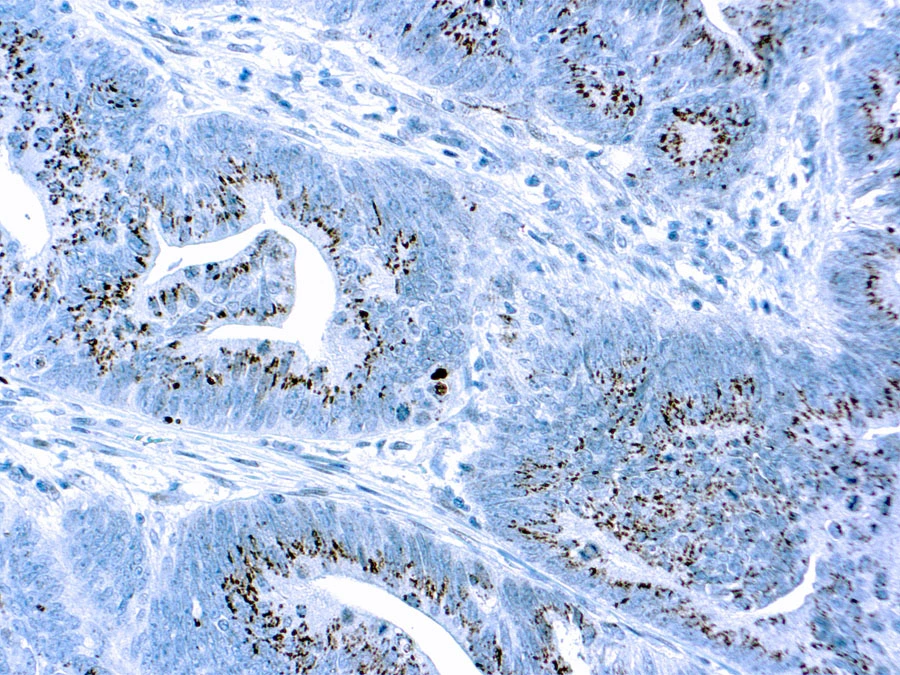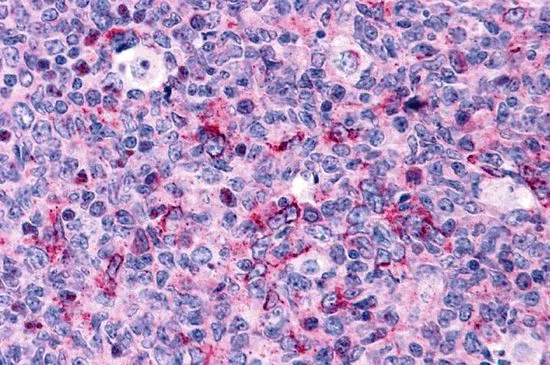![IHC-P analysis of human bladder tissue using GTX13586 Caspase 3 antibody [31A893]. Dilution : 5 microg/ml IHC-P analysis of human bladder tissue using GTX13586 Caspase 3 antibody [31A893]. Dilution : 5 microg/ml](https://www.genetex.com/upload/website/prouct_img/normal/GTX13586/GTX13586_408_IHC-P_w_23060620_340.webp)
IHC-P analysis of human bladder tissue using GTX13586 Caspase 3 antibody [31A893]. Dilution : 5 microg/ml
Caspase 3 antibody [31A893]
GTX13586
ApplicationsImmunoFluorescence, Western Blot, ImmunoCytoChemistry, ImmunoHistoChemistry, ImmunoHistoChemistry Paraffin
Product group Antibodies
TargetCASP3
Overview
- SupplierGeneTex
- Product NameCaspase 3 antibody [31A893] - Orthogonal Validated
- Delivery Days Customer9
- Application Supplier NoteWB: 2 microg/ml. IHC-P: 5 microg/ml. *Optimal dilutions/concentrations should be determined by the researcher.Not tested in other applications.
- ApplicationsImmunoFluorescence, Western Blot, ImmunoCytoChemistry, ImmunoHistoChemistry, ImmunoHistoChemistry Paraffin
- CertificationResearch Use Only
- ClonalityMonoclonal
- Clone ID31A893
- Concentration1 mg/ml
- ConjugateUnconjugated
- Gene ID836
- Target nameCASP3
- Target descriptioncaspase 3
- Target synonymsCPP32, CPP32B, SCA-1, caspase-3, CASP-3, CPP-32, PARP cleavage protease, SREBP cleavage activity 1, apopain, caspase 3, apoptosis-related cysteine peptidase, caspase 3, apoptosis-related cysteine protease, cysteine protease CPP32, procaspase3, protein Yama
- HostMouse
- IsotypeIgG1
- Protein IDP42574
- Protein NameCaspase-3
- Scientific DescriptionThis gene encodes a protein which is a member of the cysteine-aspartic acid protease (caspase) family. Sequential activation of caspases plays a central role in the execution-phase of cell apoptosis. Caspases exist as inactive proenzymes which undergo proteolytic processing at conserved aspartic residues to produce two subunits, large and small, that dimerize to form the active enzyme. This protein cleaves and activates caspases 6, 7 and 9, and the protein itself is processed by caspases 8, 9 and 10. It is the predominant caspase involved in the cleavage of amyloid-beta 4A precursor protein, which is associated with neuronal death in Alzheimers disease. Alternative splicing of this gene results in two transcript variants that encode the same protein. [provided by RefSeq]
- Storage Instruction-20°C or -80°C,2°C to 8°C
- UNSPSC12352203

![IHC-P analysis of human breast tissue using GTX13586 Caspase 3 antibody [31A893]. Dilution : 5 microg/ml IHC-P analysis of human breast tissue using GTX13586 Caspase 3 antibody [31A893]. Dilution : 5 microg/ml](https://www.genetex.com/upload/website/prouct_img/normal/GTX13586/GTX13586_409_IHC-P_w_23060620_629.webp)
![WB analysis of HL-60 cell lysate using GTX13586 Caspase 3 antibody [31A893]. Dilution : 2 microg/ml WB analysis of HL-60 cell lysate using GTX13586 Caspase 3 antibody [31A893]. Dilution : 2 microg/ml](https://www.genetex.com/upload/website/prouct_img/normal/GTX13586/GTX13586_954_WB_w_23060620_328.webp)
![WB analysis of Jurkat cell lysate treated with 2 uM staurosporine using GTX13586 Caspase 3 antibody [31A893]. WB analysis of Jurkat cell lysate treated with 2 uM staurosporine using GTX13586 Caspase 3 antibody [31A893].](https://www.genetex.com/upload/website/prouct_img/normal/GTX13586/GTX13586_955_WB_w_23060620_739.webp)
![IHC-P analysis of human bladder tissue using GTX13585 Caspase 3 antibody [31A1067]. Dilution : 1:50](https://www.genetex.com/upload/website/prouct_img/normal/GTX13585/GTX13585_404_IHC-P_w_23060620_206.webp)
![IHC-P analysis of human tonsil tissue using GTX22171 Caspase 3 antibody [3CSP03].](https://www.genetex.com/upload/website/prouct_img/normal/GTX22171/GTX22171_20191203_IHC-P_93_w_23060620_577.webp)

![WB analysis of HEK293 cell lysate using GTX30246 Caspase 3 antibody [CPP32 4-1-18].](https://www.genetex.com/upload/website/prouct_img/normal/GTX30246/GTX30246_1379_WB_w_23060722_646.webp)


![WB analysis of HeLa cells treated with camptothecin (2microM) lysate using GTX59551 Caspase 3 antibody [C33].](https://www.genetex.com/upload/website/prouct_img/normal/GTX59551/Caspase-3-antibody-C33-GTX59551-WB-1_18121409_343_w_23061123_868.webp)